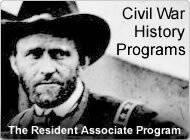
Tour Review - Clara Barton: New Discoveries and Historic Sites, with Gary Scott
The Smithsonian Associates Civil War E-Mail Newsletter, Volume 1, Number 5
After this tour, I really felt I'd time-travelled! Gary Scott gave me this feeling when he took us to the Washington sites associated with Clara Barton. These included the Patent Office where she was a clerk, a newly discovered office where she set up the Missing Soldiers Bureau, a stop at the American Red Cross building, and her final office and home in Glen Echo, Maryland. Between stops, Gary told us about her activities. These ranged from when she was a Civil War nurse; getting funding to find missing men after the war; identifying the dead and dedicating the cemetery at Andersonville; visiting Switzerland where she was inspired to create the American Red Cross; and, her adventures during the Johnstown Flood, the Franco-Prussian War, and even tending to Teddy Roosevelt's Rough Riders after the Battle of San Juan Hill.
But, feeling we were part of an historical drama came at the end of the tour. Richard Lyons, another member of the tour group, told us that he was the government employee who found Clara Barton's things in an abandoned building scheduled for demolition. Among the items he found were dresses, shoes, wallpaper (which also hangs at the Glen Echo house), and an original Roll Call list of missing men. She had lists such as this one printed and sent to every post office in the country. Civil War veterans would then look at the list and contact her if they knew the whereabouts of anyone named.
Not just words, but Lincoln's actions confirmed his commitment not to interfere with slavery. Once the war began, he did not allow attempts by generals in the field to emancipate the slaves in occupied territory. To appease the South, he proposed an amendment to the Constitution that would allow slavery to continue where it already existed. The South did not yield and the war continued. He proposed a plan to compensate slaveholders and relocate former slaves outside the United States. The South did not yield and the war continued.
Although Richard told his supervisor what he had found, the man did not want the work to be stopped and warned Richard not to interfere. Luckily for history, Richard is a Civil War buff, and was brave enough to do what was necessary to stop the demolition. Eventually, he was able to contact Gary Scott, who had the building assessed by the National Park Service and the District of Columbia Historical Society. Thanks to their efforts, the building will be preserved.
It was a fascinating story and a great treat to be able to talk to Richard about his experiences in saving the building and the artifacts. I feel part of history because I now understand the importance of historical preservation, and I know somebody who saved an important part of history from being destroyed.

